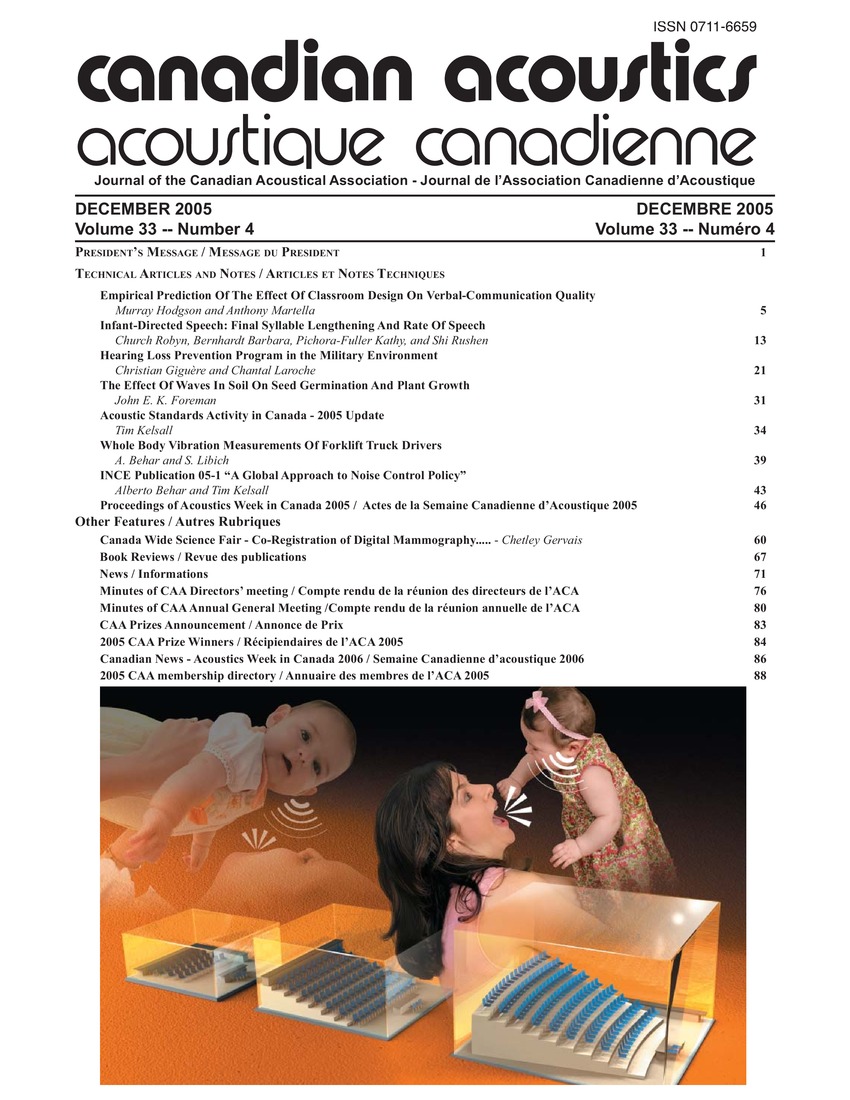Empirical prediction of the effect of classroom design on verbal-communication quality
Keywords:
Mathematical models, Optimal control systems, Quality of service, Signal to noise ratio, Design parameters, Verbal communicationAbstract
This study used empirical prediction models to investigate how verbal-communication quality in 'small', 'medium' and 'large' classrooms varies with classroom design, and identified the optimal designs. Verbal-communication quality was quantified by the room-average speech intelligibility. The design parameters studied were the occupancy, the unoccupied background-noise level, and whether or not the rooms were carpeted, had ceiling and/or wall absorption, or upholstered seats. The design parameters were varied, and the following quantities calculated: average classroom surface-absorption coefficient at 1 kHz, 1-kHz early-decay time, A-weighted background-noise level, and A-weighted speech-signal to background-noise level difference. The conditions under which optimal verbal-communication quality occurred were identified. Quality did not vary with absorption or early-decay time in any systematic way. High background noise, combined with either high absorption or low early-decay time, can lead to very low verbal-communication quality. Quality was low for negative values of signal-to-noise level, but increased quickly for higher values. In the 'small' and 'medium' classrooms, the optimal verbal-communication quality occurred with carpeting and absorption, and with un-upholstered seats. In the 'large' classroom, the optimal quality occurred with carpeting, absorption and upholstered seats. The most significant design factor in determining the verbal-communication quality of the rooms was the background noise.Additional Files
Published
How to Cite
Issue
Section
License
Author Licensing Addendum
This Licensing Addendum ("Addendum") is entered into between the undersigned Author(s) and Canadian Acoustics journal published by the Canadian Acoustical Association (hereinafter referred to as the "Publisher"). The Author(s) and the Publisher agree as follows:
-
Retained Rights: The Author(s) retain(s) the following rights:
- The right to reproduce, distribute, and publicly display the Work on the Author's personal website or the website of the Author's institution.
- The right to use the Work in the Author's teaching activities and presentations.
- The right to include the Work in a compilation for the Author's personal use, not for sale.
-
Grant of License: The Author(s) grant(s) to the Publisher a worldwide exclusive license to publish, reproduce, distribute, and display the Work in Canadian Acoustics and any other formats and media deemed appropriate by the Publisher.
-
Attribution: The Publisher agrees to include proper attribution to the Author(s) in all publications and reproductions of the Work.
-
No Conflict: This Addendum is intended to be in harmony with, and not in conflict with, the terms and conditions of the original agreement entered into between the Author(s) and the Publisher.
-
Copyright Clause: Copyright on articles is held by the Author(s). The corresponding Author has the right to grant on behalf of all Authors and does grant on behalf of all Authors, a worldwide exclusive license to the Publisher and its licensees in perpetuity, in all forms, formats, and media (whether known now or created in the future), including but not limited to the rights to publish, reproduce, distribute, display, store, translate, create adaptations, reprints, include within collections, and create summaries, extracts, and/or abstracts of the Contribution.


